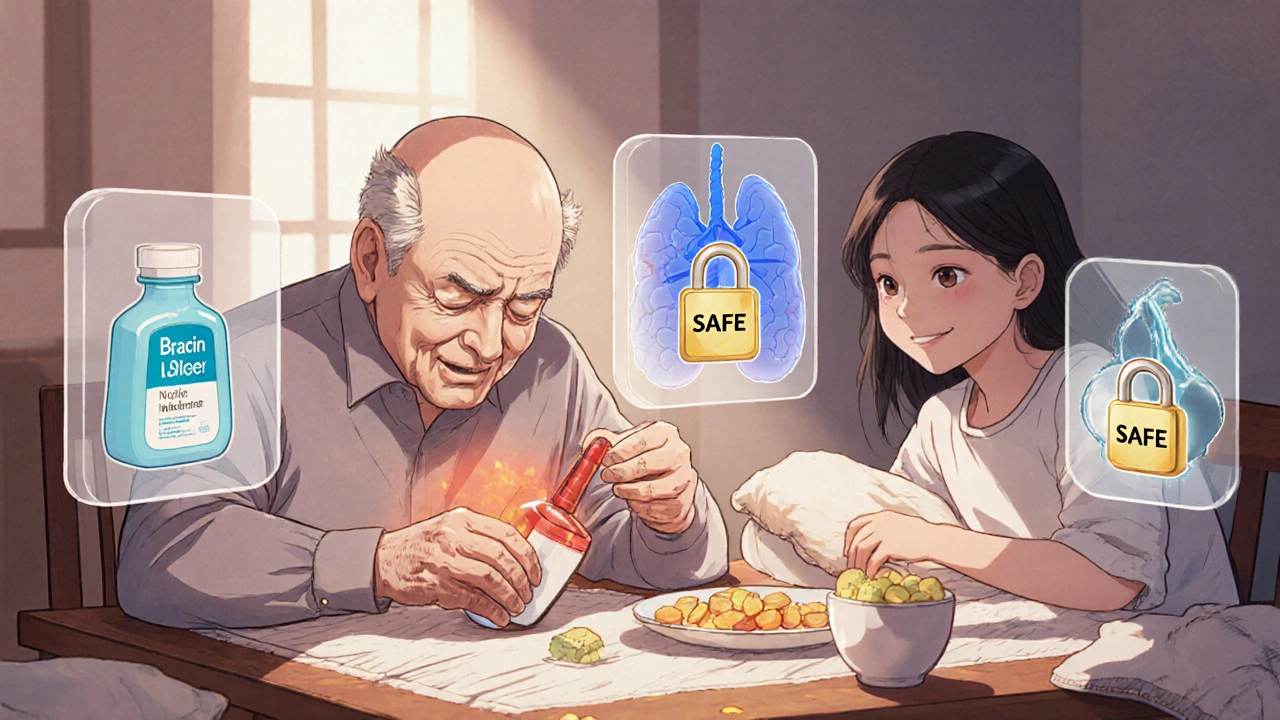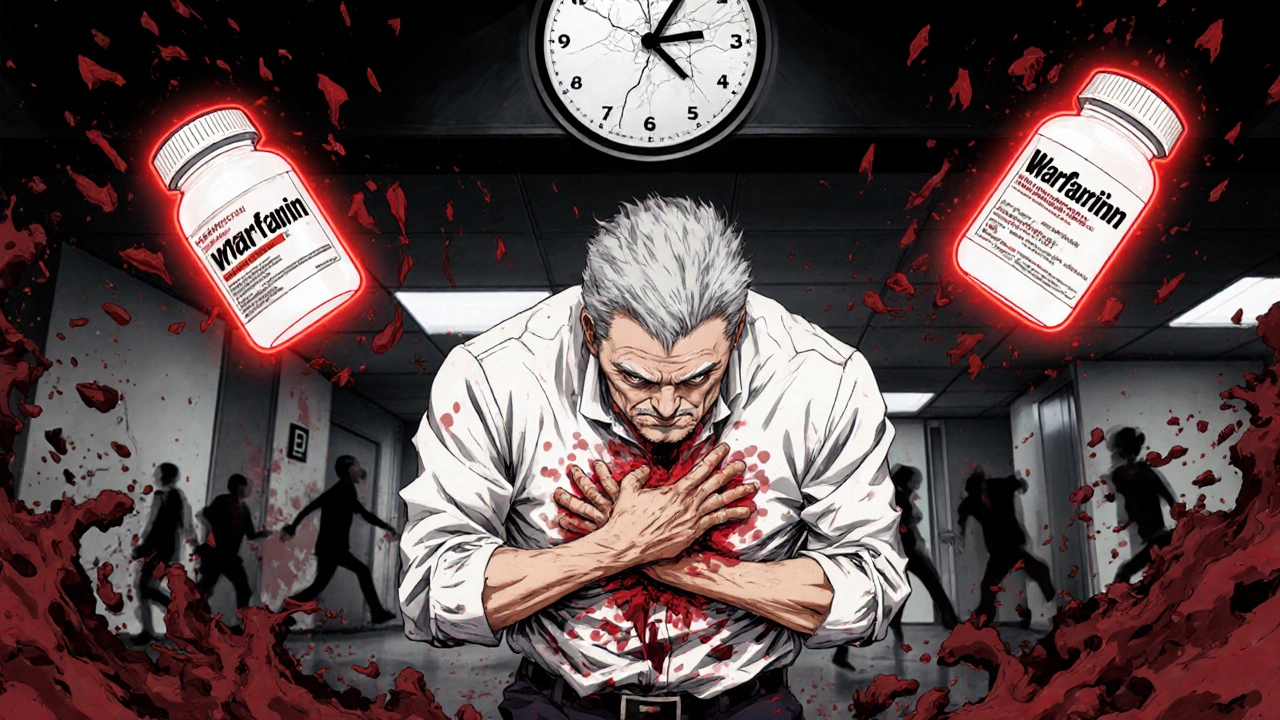Combining blood thinners with common pain relievers like ibuprofen or naproxen isn’t just a bad idea-it’s dangerous. Every year, thousands of people end up in the hospital because of this mix, and many don’t even realize they’re at risk. If you’re on a blood thinner for atrial fibrillation, a past blood clot, or another condition, and you reach for an over-the-counter pain pill for your arthritis or back pain, you could be putting yourself in serious danger.
Why This Combination Is So Risky
Blood thinners work by stopping your blood from clotting too easily. That’s good if you’re at risk for stroke or clots, but it means your body has less ability to stop bleeding when it happens. NSAIDs-like ibuprofen (Advil, Motrin), naproxen (Aleve), and diclofenac (Voltaren)-do something else: they block enzymes in your body that help platelets stick together. Platelets are the first responders when you cut yourself. Without them, even a small injury can lead to prolonged bleeding. When you take both together, you’re hitting your body’s clotting system from two sides. It’s like turning off two safety valves at once. The result? Your blood can’t seal small leaks, and even minor damage inside your stomach, brain, or lungs can turn into major bleeding. A 2024 study tracking over 51,000 people on blood thinners found that those who also took NSAIDs were more than twice as likely to be hospitalized for bleeding. That’s not a small increase-it’s a massive jump in risk. And it doesn’t matter whether you’re on warfarin or one of the newer blood thinners like apixaban or rivaroxaban. The danger is the same.Not All NSAIDs Are Equal
Some NSAIDs are worse than others when mixed with blood thinners. The Danish study that tracked these patients found clear differences in risk:- Naproxen raised bleeding risk by 4.1 times
- Diclofenac raised risk by 3.3 times
- Ibuprofen raised risk by 1.79 times
Bleeding Isn’t Just in the Stomach
Most people assume the biggest danger is a stomach ulcer or GI bleed. That’s a big part of it-but it’s not the whole story. The same 2024 study found that combining blood thinners with NSAIDs also raised the risk of bleeding in other areas:- Gastrointestinal bleeding: 2.24 times higher
- Intracranial bleeding (bleeding in the brain): 3.22 times higher
- Pulmonary bleeding (in the lungs): 1.36 times higher
- Urinary tract bleeding: 1.57 times higher

What About Acetaminophen?
If you’re on a blood thinner and need pain relief, there’s a safe alternative: acetaminophen (Tylenol). Unlike NSAIDs, it doesn’t affect platelets or the stomach lining. It won’t increase your bleeding risk. It’s not perfect-it won’t reduce inflammation like ibuprofen does-but for pain from headaches, muscle aches, or arthritis, it works well for most people. The American College of Cardiology recommends it as the first choice for anyone on anticoagulants. If acetaminophen isn’t enough, talk to your doctor about non-drug options: heat packs, cold therapy, physical therapy, or even acupuncture. These don’t carry any bleeding risk and can be surprisingly effective.What If You Absolutely Need an NSAID?
Sometimes, there’s no way around it. Maybe you have a flare-up of gout, severe tendonitis, or a sudden injury. In those cases, your doctor might say it’s okay to use an NSAID-but only under strict conditions:- Use the lowest effective dose for the shortest time possible
- Avoid daily use-only take it for 1-3 days at most
- Never combine it with aspirin or other blood thinners unless under direct supervision
- Ask about a proton pump inhibitor (PPI) like omeprazole to protect your stomach

What You Need to Do Right Now
If you’re on a blood thinner, here’s what you should do:- Check your medicine cabinet. Do you have ibuprofen, naproxen, or diclofenac at home? Even if you haven’t used them in months, keep them out of reach.
- Ask your pharmacist. Bring all your meds-including vitamins, supplements, and OTC pills-to your next pharmacy visit. Pharmacists can spot dangerous combinations you might miss.
- Be honest with your doctor. Many people don’t mention OTC meds because they think they’re “not real drugs.” But they are. Tell your doctor if you’ve taken Advil for a headache last week.
- Replace NSAIDs with acetaminophen. Switch your go-to painkiller now, before you need it.
Why This Problem Is Getting Worse
More people are on blood thinners than ever before. About 3 to 6 million Americans take them for atrial fibrillation, deep vein clots, or heart valve replacements. At the same time, Americans buy over 30 billion OTC ibuprofen tablets every year. That’s a huge overlap. Doctors are starting to catch on. Hospitals are building systems to flag patients who are prescribed both types of drugs. But patients still need to be their own advocates. No electronic system will remind you if you pick up a bottle of Aleve at the grocery store. The bottom line? If you’re on a blood thinner, treat NSAIDs like you would a live wire: avoid them unless you’ve talked to your doctor-and even then, proceed with extreme caution.What to Do If You’ve Already Taken Them Together
If you’ve accidentally taken an NSAID while on a blood thinner, don’t panic. But do pay attention:- Watch for signs of bleeding: black or tarry stools, vomiting blood, unusual bruising, headaches that won’t go away, dizziness, or blood in your urine.
- If you notice any of these, call your doctor or go to the ER immediately.
- Don’t wait to see if it gets better. Bleeding can escalate fast.
Can I take aspirin with my blood thinner?
No. Aspirin is also an NSAID and blocks platelet function. Taking it with a blood thinner doubles your bleeding risk. Even low-dose aspirin (81 mg) is dangerous unless your doctor specifically prescribed it as part of your treatment plan. Never combine aspirin with other blood thinners without medical approval.
Is Tylenol (acetaminophen) safe with blood thinners?
Yes, acetaminophen is generally safe for people on blood thinners. It doesn’t affect platelets or the stomach lining, so it doesn’t increase bleeding risk. It’s the preferred pain reliever for patients on anticoagulants. Just don’t exceed 3,000 mg per day to avoid liver damage.
Do newer blood thinners (DOACs) interact less with NSAIDs than warfarin?
No. Studies show that the bleeding risk from combining NSAIDs with blood thinners is just as high whether you’re on warfarin or a DOAC like apixaban, rivaroxaban, or dabigatran. The danger isn’t about the type of blood thinner-it’s about the NSAID. All anticoagulants increase bleeding risk when paired with NSAIDs.
Can I take a topical NSAID cream instead?
Topical NSAIDs like diclofenac gel (Voltaren Gel) are absorbed in much smaller amounts than pills, so they carry less risk. But they’re not risk-free. Some studies suggest even topical NSAIDs can raise bleeding risk in people on blood thinners, especially if used over large areas or for long periods. Talk to your doctor before using them.
What should I do if I’m on a blood thinner and have chronic pain?
Don’t rely on NSAIDs. Work with your doctor to create a pain management plan that includes acetaminophen, physical therapy, heat/cold therapy, weight management, and possibly non-NSAID prescription pain meds like gabapentin or duloxetine. Many people find that combining several low-risk strategies works better than one high-risk pill.


Erika Sta. Maria
November 22, 2025 AT 02:22So let me get this straight-we’re telling people to avoid ibuprofen like it’s radioactive, but acetaminophen is fine? 😏 Meanwhile, 80% of the world uses NSAIDs daily and somehow isn’t dropping dead? I mean, my abuela in Manila takes diclofenac with warfarin and still dances at weddings. Maybe the real problem is over-medicalizing normal pain? 🤷♀️
Debanjan Banerjee
November 22, 2025 AT 13:06There’s a critical misunderstanding here. The study cited shows relative risk, not absolute risk. For a healthy 65-year-old on apixaban, the baseline annual risk of GI bleed is ~1%. Doubling that to 2% is statistically significant but not catastrophic. The real danger is in elderly patients with comorbidities-hypertension, renal impairment, H. pylori. For most people, occasional ibuprofen (500mg, 1-2x/week) is low-risk if no other red flags. Don’t panic. Just be informed.